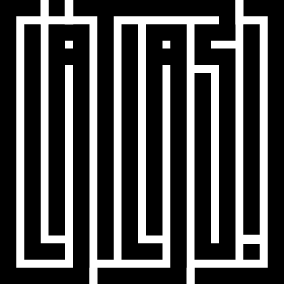 |
|
|
 |
|
|
My name is l’Atlas, I live in Paris since my childhood, my roots stay in the south west of France as I was born near Toulouse (no coincidence if I represent for South painters!). I started tagging in 1991, in the corridors of Lycee Voltaire (75011) with classmates like Elger, Stor, Dj feadz… At the time I used to write “Socle” (Pedestal in English), already with my ideas of underground layers.
Then in 1995 I went for Atlas so that the whole world could hear my name, no matter the language.
At the beginning of 1996 with Elger and Coers, we created VAO which would bring together all the buddies coming from graffiti, that had another idea of its representation.

It is continuity. I consider the tag as a layer in the history of writing. The tag remains the imprint of the unique gesture, inherited form calligraphy.
Also after 3 or 4 beers, a good fat cap is the lushest thing ever, isn’t it?

You multiply the techniques and medium: spraying, pasting, sticky tape, canvas, video… are you always looking for innovations?
No matter the medium, I aspire to remain with time and go through the net of this system of eradication of memory in which we evolve.
You went to study calligraphy in the Moroccan Atlas with a classical master, then in Egypt with a modern master. How did you meet these “masters”? Are they used to teach Europeans? Tell us about this initiation.
The first master is called Smail Bour Quaiba, he is one of the last Moroccan calligraphist. I met him in Toulouse during my studies of History of Art and Archaeology, as I was working freelance for “Horizons Maghrebins “, a book about artistic relationships between the East and the West. I was in charge of the hanging of his exhibition… and we got on well with each other. He invited me in the Atlas, where I stayed for three months, doing 5 hours of classical calligraphy a day.
After that I never went back to university where just one man talks for five hundred.
In Cairo I accidentally met
Munir Al Shaarani, a Syrian political refugee chased by the Iraqi government for communism.
He was much more “modern”, had followed a classical calligraphy training, but had also been working in a design and architecture school. He mixes the three forms of Art, and is for me the greatest calligraphist on earth. He taught me Geometry … I owe him everything. He uses colour.

With your curiosity for calligraphy techniques, would you be interested in other alphabets (Hebrew, Cyrillic, Chinese…)?
I have also studied Hebrew calligraphy at the same time as Arabic. They are both Semitic and tricosonnatic languages, two sisters. I have studied Russian for 6 years in school, and have taken part in numerous Chinese calligraphy workshops.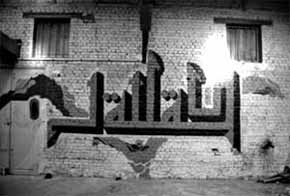
Your photos, like your work, are generally in black and white. Do you believe, like Jacques Tati, that “the colour distracts the viewer”?
First of all the use of black and white in my posters is for me a form of resistance, when town planners (and artists!) are loosing it; I will only take as example the beautiful green of the Mairie de Paris. The Black and the white then become a hyphen, a binding line, a breath, between the people and the city.
Then the choice of black and white, for the photos themselves, is meant to make the city readable, in the same way a text is readable; (both my grandfathers were editors…) the artifice of colour disappears to let the reading free.
Finally the black and white tells the presence of something that has disappeared.
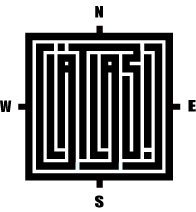
A book is about to come out. Was it your idea or did and editor contact you? What will it present? Your most recent works, or is it retrospective?
The editor is Didier Levallois, from Criteres Urbanites, who I met through Daniel Cresson.
It is deliberate that there is no graffiti in this book. I want to show that people with this background also have a personal one, a curiosity for other cultural influences as important as the heritage of New York graffiti. I bring back the memory of Arabic writing in the heart of occidental culture, so that we do not forget the part that the East has had in the erecting of the West, before it was drowned in it.
More than a third of the words we use come from Arabic, mixed with Greek and Latin.
The book is named l’Art du sens (the Art of sense). It is organised in 4 cardinal points;
- the compass
- the posters
- the exhibitions
- the collaborations in the streets with the buddies, always the same ones: Pablow, Elger, Teurk, Sunset, G, Tanc, Aleteïa...
This last section about other people could have been replaced by photos of the “toiles errantes”, but for me the failure of contemporary artists is to always work alone. Ideas come from discussion with others. “The other is the deliverer”
You are part of the “Acrylonumerik” project. I understand this is a happening mixing projected videos, pasting, and live painting. Can you describe the project and who else is part of it?
Actually this project couldn’t exist without a collaboration; Jaïmito and Gilbert (12 12 collective) are the initiators of the project.
The concept is to mix real painting and digital painting through graphic artists using beamers during a performance based on a scenario. The best thing to do is to have a look at the website www.akrylonumerik.com.
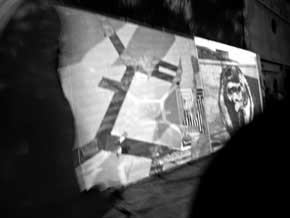
I think you are preparing an exhibition with Pablow, Sun7 and Tanc, in Brussels. Can you tell us about it?
This exhibition will be called UNDER CONTROL.
It will develop the idea that we are being controlled, using a mise-en-scene of characters from Pablow, linked with wires to a central Spirit that gives instructions.
A simple metaphor of our contemporary life.
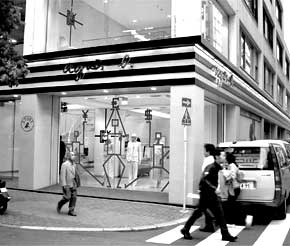
Through the decoration of shops, the edition of tee-shirts… Agnes B. often works together with you. Can you tell us in what way this fashion woman is interested by the art world?
I have met Agnes B. in 1998 while I was destroying one of her delivery trucks at lunchtime on the Canal St Martin, a nice fat cap how I know. Agnes likes people who like to display themselves. She shot several films of my tags in Paris, and wanted to make tee-shirts with them. It wasn’t really going anywhere; I was going my own way. I was coming back from Cairo when she offered me to take part in an exhibition about graffiti in 2001 at Gallerie du Jour. I showed a video; in parallel Sam Bern painting the Parisian sidewalks, and a classical calligraphy, the first sentence of the Koran written with chalk on a blackboard. One again, I am trying to show that beyond cultural and social considerations, exists a universal energy that drives men to leave an imprint of their gesture through time.
Meanwhile, the twin towers collapsed.
Then a lot of things followed others. I got busted, I met Jean Faucheur, I made my first canvases, I started with posters, I vectorized all my logos, Agnes printed it all on a black and white tee-shirt series, she gave me entire freedom, I decorated her shops B sport with black tape, the Japanese invited me to do the same in Tokyo… there I shot videos of Japanese calligraphists…
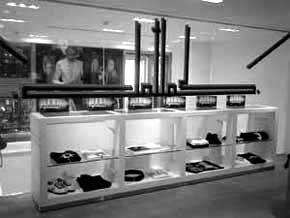
Just as electro musicians often give credit to their rock influences, graffiti artists evolving with post-graffiti like to mention their non-graffiti-scene influences. Who are the people who have had an influence on your evolution? Are there some who you would like to collaborate with?
According to you, who is the next person I should interview on ekosystem?
A girl !!!
* L'Atlas.net
* L'Atlas'fotolog
* T-Shirts 1 - TS 2 - TS 3
ekosystem.org :: December 2004
Special thanks to zomas for the english translation + G.
Slideshow coded by v3ga withProcessing.
